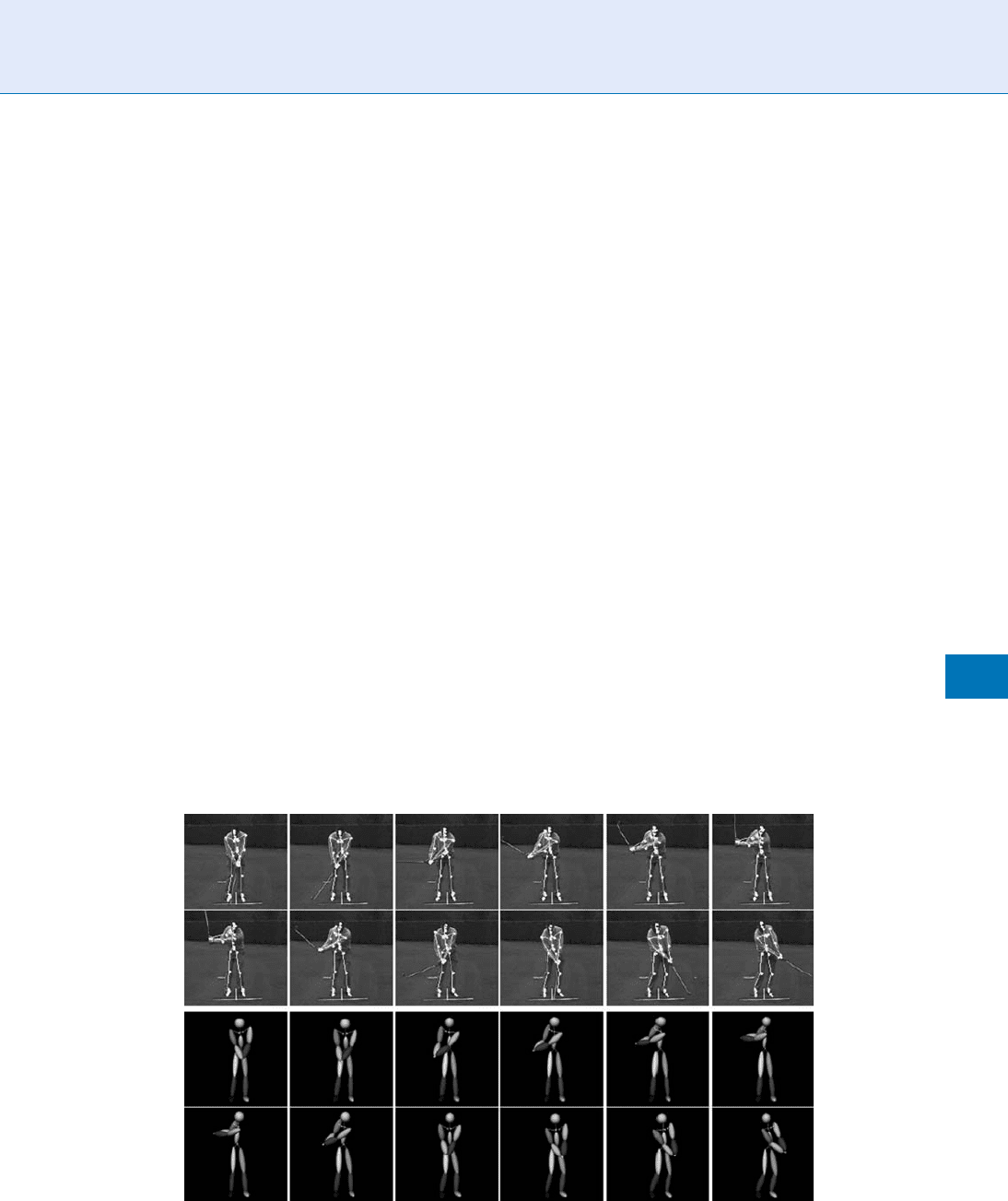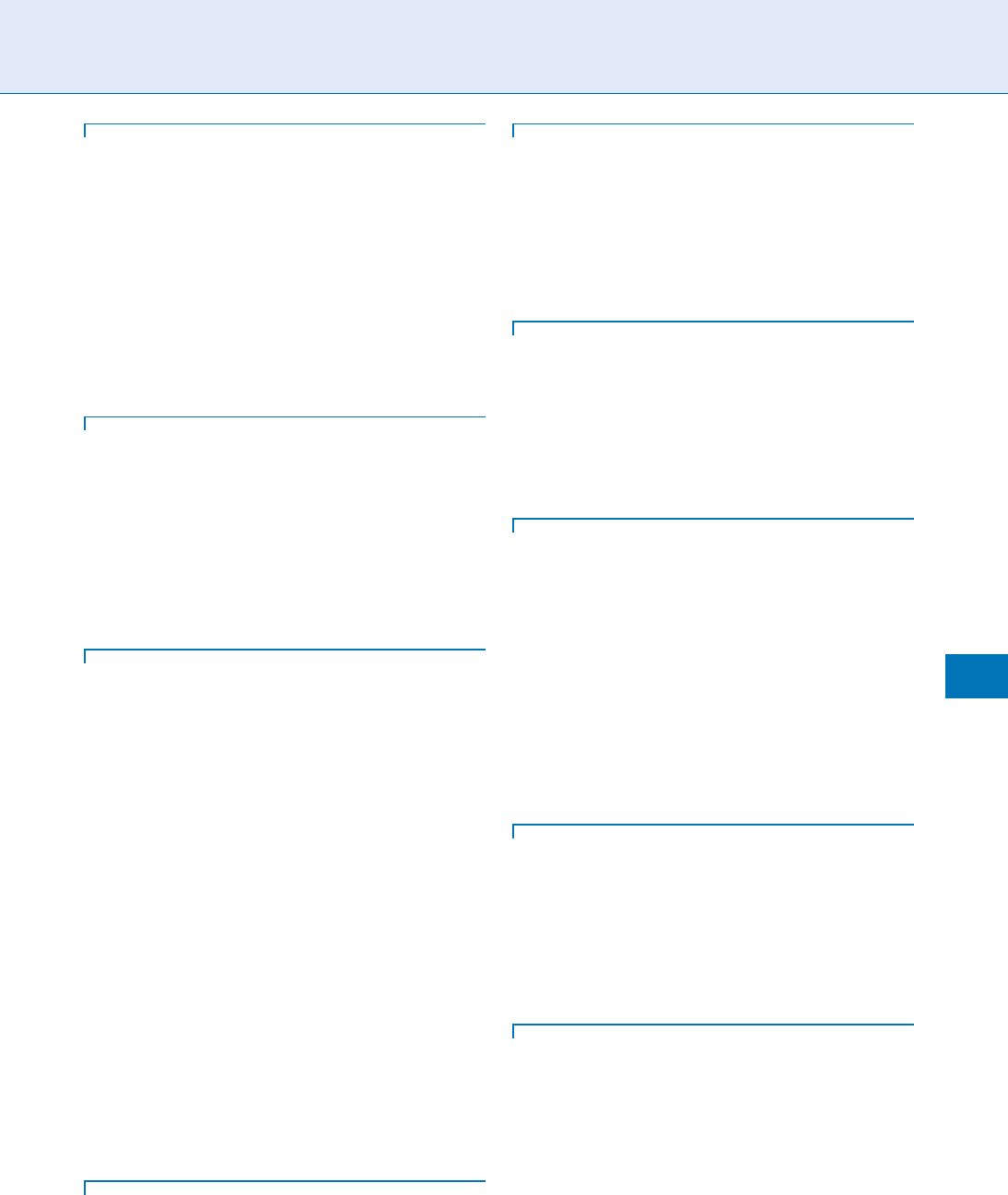Li S.Z., Jain A.K. (eds.) Encyclopedia of Biometrics
Подождите немного. Документ загружается.


Multi-Camera Modeling
Many methods that derive the 3D pose of a person
from 3D shape sequences reconstructed from multiple
views have been proposed. A popular approach is to fit
a skeleton parameterized in terms of its joint angles to
the visual-hull derived from body outlines [3], as illu-
strated by Fig. 1b–d. In a controlled environment this
can be done in real-time but requires great care during
the imaging process to ensure that the silhouettes can
indeed be extracted reliably. An alternative is to extract
stereo data using camera pairs and fitting the body
model to the resulting 3D point cloud. In both cases,
the process can be initialized by asking the subject to
perform a sequence of known motions to estimate
body proportions and calibrate the system.
Until recently, most of these approaches relied on
deterministic gradient descent techniques combined
with the exten ded Kalman filter to iteratively estimate
changes in pose and motion. A common limitation
of these techniques is the use of a single pose or state
estimate which is updated at each time step. In prac-
tice, if the movement is too fast or if the image data
can be accounted for almost as well by more than
one pose, pose estimation may fail catastrophically.
Monte Carlo-based tracking techniques, such as
particle filtering [5], were introduced to deal with
such failures by simultaneously considering multiple
hypotheses in a principled way. The principal difficulty
with their application to human pose estimation is
the dimensionality of the state space. The number of
samples or particles required increases exponentially
with dimensionality. Recent work has therefore com-
bined stochastic and gradient descent search to achieve
both computational efficiency and robustness.
Techniques have also been developed to recover
not only kinematic but also morphologic models,
that account for body deformation during motion.
These rely on machine learning approaches to per-
form dimensionalit y reduction of human shape
variability and produce models [6] that can be fitted
to noisy image data.
These effor ts have been successful to the point
where commercial systems are now becoming avail-
able. However, they usually only capture rough poses
of the torso, arms, and legs whi le d etails such as
hand-orientation or axial arm rotation are missing.
Furthermore, the pose approximations are only
dependable if the model fitted to the image data is a
reasonable initial approximation of the person’s body
shape. The commercial systems therefore commonly
assume short hair and close fitting clothing, which
limits their generality.
Single Camera Modeling
Many recent approaches are trying t o overcome the
difficulties inherent to single-camera tracking. They
can be classified as follows:
1. Detect. This implies recognizing postures from a
single image by matching it against a database and
has become increasingly popular but requires very
large sets of examples to be effective. Approaches of
this kind have been successfully demonstrated for
pedestrian detection [7].
2. Track.Thisinvolvespredictingtheposeinaframe
given the pose in the previous frame. This requires an
initial pose and can easily fail if errors start accumu-
lating in the prediction, causing divergence in the
estimation process. As in the multi-camera case, this
can be mitigated by introducing stochastic optimi-
zation techniques that can handle multiple compet-
ing hypotheses [5]. An effective alternative is to
introduce strong dynamic motion models as priors
on the search space, as will be discussed below.
Detection and tracking are complementary in
many respects. They have been profitably combined
to track automatically multiple people in extremely
long sequences [8, 9]: Tracking takes advantage of
temporal continuity and the smoothness of human
motions to accumulate information throug h time,
while detection techniques are likely to be useful for
initialization of tracking and search. With suitable
dynamical models, tracking has the additional advan-
tage of providing parameter estimates that may be
directly relevant for subsequent recognition tasks
with applications to biometrics, sport training, phys-
iotherapy, or clinical diagnostics.
Motion Models
Pose and motion models may be generic or activity
specific. Many researchers adopt generic models that
encourage smoothness while obeying kinematic joint
limits. Such models are often expressed in terms of
960
M
Markerless 3D Human Motion Capture from Images

first- or second-order Markov models. Activity-specific
models more strongly constrain 3D tracking and
help resolve potential ambiguities, but at the cost of
having to infer the class of motion, and to learn the
models.
The most common approach to learning activity-
specific models of motion or pose has been to use optical
motion capture data from one or more people
performing one or more activities, such as walking, run-
ning, or jumping. Given the high-dimensionality of the
data it is natural to try embedding it in a low-dimensional
space [10]. However, the highly nonlinear nature of the
manifold of possible human poses makes it difficult.
Thus, methods for nonlinear dimen sionality reduction
have gained in popularity. This approach is illustrated
by Fig. 2 in which the motion model is expressed in
terms of a Gaussian process latent variable model [11].
Instead of modeling the pose space, one might
directly model the space of human motions, in which
consecutive poses are concatenated into a g lobal
motion vector. Motion subspace models learned from
multiple people performing the same activity have
long been used in the animation community. They
have also been successfully used for 3D people tracking
[12, 13]. For the restricted class of cyclic motions,
an automated procedure for aligning training data
as a precursor to PCA was developed [12]. Similarly,
a related class of subspace models for walking
motions in which the temporal variations in pose is
expressed in terms of sinusoidal basis functions
has been proposed [14]. It has been shown that
three harmonics are sufficient for reliable gender
classification.
Biometric Applications
Most image-based approaches to person identification
on the basis of the way they move can be classified into
two broad categories: Appearance-based ones that deal
directly with image statistics and model-based ones
that first fit a model to the image data and then analyze
the variation of its parameters.
Until now, because the model-based approaches
have been so brittle, the majority of published
approaches fall into the first category. Some rely on
first processing each frame independently and then
using a Hidden Markov Model to model the transi-
tions from one fram e to the next [15]. Others exploit
the spatio-temporal statistics of the image stream [16].
Methods that rely on dense optical flow [17] or self
similarity plo ts computed via correlation of pairs of
images have also been proposed. The main drawback
of these appearance-based approaches is that they are
Markerless 3D Human Motion Capture from Images. Figure 2 Tracking of a golf swing using a single video camera.
First two rows: The skeleton of the recovered 3D model is projected into a representative subset of images. Bottom two
rows: Volumetric primitives of the recovered 3D model projected into the same views.
Markerless 3D Human Motion Capture from Images
M
961
M

usually designed only for a specific viewpoint, usually
fronto-parallel. Furthermore guaranteeing robustness
against clothing and illumination changes remains
difficult even though much effort has been expanded
to this end, for example , by using silhouettes and
binary masks rather than the image pixels gray levels
themselves.
With their increasing competence, the 3D model-
based approaches can be expected to eventually over-
come these limitations. Already some of them have
shown promise. For example, in [18], leg motion is
extracted by temporal template matching using a
model defined by forced coupled oscillators. Individ-
ual signatures are then derived by Fourier analysis.
Another recent good example of model-based gait
recognition can be found in [19]. The gait signature
is extrac ted by using Fourier series to describe the
motion of the upper leg and by applying temporal
evidence gathering techniques to extract the moving
model from a sequence of images. However these tech-
niques are still 2D, which means that a near fronto-
parallel view is assumed. This approach has been
extended to full 3D modeling by replacing the Fourier
analysis by fitting PCA-based motion models to the
image data [20].
Summary
In recent years, video-based human motion capture
has made very significant advances, which are driven
by demands of potential mass-market applications.
Multi-camera systems are beginning to reach a level of
maturity that makes them of practical use but are some-
what harder to deploy and calibrate than single-camera
systems. These, while still far from the robustness that
would make them commercially viable, are also progres-
sing fast. In particular, they now take advantage of
sophisticated statistical learning techniques to develop
effective motion models and overcome the ambiguities
inherent to monocular 3D reconstruction.
Biometrics approaches are beginning to take advan-
tage of this increasing competence to recognize people
on the basis of how they move in 3D. This holds the
promise of techniques that will be easy to deploy be-
cause they will only require simp le and cheap sensors,
such as one or more webcams, able to operate in un-
controlled environments in which the subjects can
move freely.
Related Entries
▶ Deformable Models
▶ Human Detection and Tracking
▶ Machine-Learning
▶ Gait Recognition, Motion Analysis for
References
1. Muybridge, E.: Animals Locomotion. University of Pennsylvania
(1887)
2. Marey, E.J.: Le mouvement. Editions Jaqueline Chambon (1994)
Re
´
e
´
dition de 1894 des e
´
ditions Masson
3. Muendermann, L., Corazza, S., Andriachhi, T.: The evolution of
methods for the capture of human movement leading to mar-
kerless motion capture for biomedical applications. J. Neu-
roEng. Rehabil. 3 (2006)
4. Moeslund, T., Hilton, A., Krueger, V.: A survey of advances in
vision-based human motion capture and analysis. Comput.
Vision Image Understand 2, 90–126 (2006)
5. Deutscher, J., Blake, A., Reid, I.: Articulated body motion cap-
ture by annealed particle filtering. In: Conference on Computer
Vision and Pattern Recognition, Hilton Head Island, SC,
pp. 2126–2133 (2000)
6. Anguelov, D., Srinivasan, P., Koller, D., Thrun, S., Rodgers, J.,
Davis, J.: Scape: shape completion and animation of people.
ACM Trans. Graphics 24, 408–416 (2005)
7. Seemann, E., Leibe, B., Schiele, B.: Multi-aspect detection of
articulated objects. In: Conference on Computer Vision and
Pattern Recognition, New York, NY, USA (2006)
8. Ramanan, D., Forsyth, A., Zisserman, A.: Tracking people by
learning their appearance. IEEE Trans. Pattern Anal. Mach.
Intell. (2007)
9. Fossati, A., Dimitrijevic, M., Lepetit, V., Fua, P.: Bridging the gap
between detection and tracking for 3D monocular video-based
motion capture. In: Conference on Computer Vision and Pat-
tern Recognition, Minneapolis, MI (2007)
10. Murase, H., Sakai, R.: Moving object recognition in eigenspace
representation: Gait analysis and lip reading. Pattern Recognit.
Lett. 17, 155–162 (1996)
11. Urtasun, R., Fleet, D., Hertzman, A., Fua, P.: Priors for people
tracking from small training sets. In: International Conference
on Computer Vision, Beijing, China (2005)
12. Ormoneit, D., Sidenbladh, H., Black, M., Hastie, T.: Learning
and tracking cyclic human motion. In: Neural Information
Processing Systems, pp. 894–900 (2001)
13. Sidenbladh, H., Black, M.J., Fleet, D.J.: Stochastic tracking of 3D
human figures using 2D image motion. In: European Confer-
ence on Computer Vision (2000)
14. Troje, N.: Decomposing biological motion: A framework for
analysis and synthesis of human gait patterns. J. Vision 2,
371–387 (2002)
15. He, Q., Debrunner, C.: Individual recognition from periodic
activity using Hidden Markov Models. In: IEEE Workshop on
Human Motion, Austin, Texas (2000)
962
M
Markerless 3D Human Motion Capture from Images

16. Niyogi, S., Adelson, E.H.: Analyzing and recognizing walking
figures in XYT. In: Conference on Computer Vision and Pattern
Recognition, Seattle, WA (1994)
17. Little, J., Boyd, J.: Recognizing people by their gait: the shape of
motion. Videre 1, 1–32 (1986)
18. Yam, C.Y., Nixon, M.S., Carter, J.N.: On the relationship of
human walking and running: automatic person identification
by gait. In: International Conference on Pattern Recognition,
Quebec, pp. 287–290 (2002)
19. Cunado, D., Nixon, M., Carter, J.: Automatic extraction and
description of human gait models for recognition purposes.
Comput. Vision Image Understand 90, 1–41 (2003)
20. Urtasun, R., Fleet, D., Fua, P.: Temporal motion models for
monocular and multiview 3-D human body tracking. Comput.
Vision Image Understand 104, 157–177 (2006)
Match Score Fusion
▶ Fusion, Score-Level
Matcher
A biometric identification system that compares the
templates stored during user enrollment with those
extracted from the presented biometric samples and
generates a matching score. The module that generates
this matching score is referred to as matcher.
▶ Fusion, Rank-Level
Matching
▶ Biometric Algorithms
Matching Score
A quantitative measure related to the similarity among
a biometric trait and a user template. From a pattern
classification point of view, matching scores are usually
related to the likelihood of a template of being from a
class. In general, given a biometric sample, the higher
the matching score, the higher is the probability that it
belongs to the claimed user. Matching scores are pro-
duced by the matcher module of a biometric system.
▶ Signature Matching
Match-On-Card
Match-on-card is a technology that enables a system to
match between the tem plate and the sampled data on a
smart card. With this technology, templates will never
be transmitted to any other devices or storage systems,
which suppresses the risk of unauthorized template
duplication. Since the matching process is executed
by a relatively small CPU that is mounted on the
smart card, the processing time is typically longer
than other systems using common CPUs for PC.
▶ Finger Vein Reader
▶ Transportable Asset Protection
Maximum A Posteriori (MAP)
Maximum A P o steriori estimation is to estimate a stoc-
hastic variable with both prior distribution and conditi-
onal likelihood function. It can be seen as a regularization
of Maximum Likelihood Estimation (MLE).
▶ Iris Super-Resolution
Maximum A-Posteriori Estimation
Method of parameter estimation in which a parameter
is estimated using the data and a prior di stribution
over the parameter one wants to estimate.
▶ Gaussian Mixture Models
Maximum A-Posteriori Estimation
M
963
M

Maximum Likelihood Estimation
Method of parameter estimation in which a parameter
is estimated to be that value for which the data are
most likely.
▶ Gaussian Mixture Models
Maximum Margin Classifier
▶ Support Vector Machine
Maximum Permissible Exposure
(MPE)
The highest exposure to which a subject may be sub-
jected without adverse effect. Similar to but distinct from
threshold limit value. Similar also to PEL, permissible
exposure level, which is a legal term in some jurisdictions
that defines the legally permissible exposure limit.
▶ Iris on the Move
Mesocephalic
Mesocephalic is the head form that is intermediate
between brachycephalic and dolicocephalic forms.
▶ Anatomy of Face
Metatarsal Ridge
Metatarsal ridge is defined as the leading edge of the
impression made by the ball area of the foot.
▶ Forensic Barefoot Comparisons
Microphone
▶ Voice Device
Microphone Arrays
Microphone arrays are composed of several microphones
located at fixed relative positions from each other. They
use knowledge of the microphone locations to predict the
delays observed in signals coming from different direc-
tions. This allows two different possibilities: finding the
position of a sound source (for instance to aim a video-
conferenc e camera at the speaker), and reducing the
noise of the captured signal by enhancing the sensitivity
of the microphone array in a particular direction. This is
achieved by adequately combining the signals captured
by the different microphones in the array.
▶ Voice Device
Minimal Constraint Iris Recognition
▶ Iris on the Move™
Minutia
Minutia are the points in the fingerprint where the
finger ridges split (a bifurcation point) or terminate
(an ending point).
Minutia is the basis for recognizing a fingerprint in
early law enforcement applications and has gradually
become the standard of fingerprint template.
▶ Large Scale System Design
964
M
Maximum Likelihood Estimation

Minutia Direction
The tangential direction of the ridge or valley at the
minutia point.
▶ Fingerprint Features
Mislabeled Iris Data Correction
▶ Automatic Classification of Left/Rig ht Iris Images
Mitochondrial DNA
Mitochondria are organelles in our cells that are asso-
ciated with the production of energy. Mitochondrial
DNA (mtDNA) is a circular DNA present in mitochon-
dria and not in the cell nucleus. There are on average
100–1,000 mitochondria per cell. Each mitochondrion
contains a dozen of copies of mtDNA. Therefore each
cell contains 1,000–10,000 copies of mtDNA, instead of
two for ‘‘normal’’ or nuclear DNA. mtDNA is therefore
very useful for degraded samples. It is transmitted by the
mother and its polymorphism is limited (the chance of
finding the same sequence in two unrelated individuals
is on average 1 in 1,000).
▶ Forensic DNA Evidence
Mixture Mode
▶ Gaussian Mixture Models
Model-Based Biometrics
▶ Biometric Sample Synthesis
Monitoring
▶ Surveillance
Monomodal/Multimodal Database
A monomodal database is a database which only has
one biometric trait sensed. A multimodal database is a
database which has more than one biometric trait from
the same individual.
▶ Fingerprint Databases and Evaluation
Morphable Models
▶ Deformable Models
Mosaicing
The process of creating a composite image from over-
lapping component images is called mosaicing. In
biometrics, mosaicing techniques are used to integrate
multiple information for improving recognition
performance.
▶ Fingerprint Templates
▶ Fusion, Sensor-Level
Mosaicing
M
965
M

Motion Capture
Digitally recording motions by recovering the succes-
sive 3D joint angles that characterize them. Most cur-
rent systems rely on specialized sensors attached to the
performer’s body or on imaging markers worn by the
subject.
▶ Markerless 3D Human Motion Capture from
Images
Motion Estimation
Face tracking can be looked upon as estimating the
motion of the face over subsequent video frames. This
can be the 2D motion on the image plane or the 3D
pose of the face.
▶ Face Tracking
Motion Model
Motion model describes the timing and displacement
of each structure such as limbs, head, and torso that
makes up a particular body. The motion is dependent
on the structural mode l. Motion displacement is nor-
mally expressed in angle or distance.
▶ Gait Recognition, Model-Based
Motion Recovery, 3D
▶ Markerless 3D Human Motion Capture from Images
Moving Light Display
A technique pioneered by Johansson [1] for use in
psychological experiments to isolate a motion stimulus
by acquiring images of lights placed on the body joints.
▶ Gait Recognition, Silhouette-Based
MS
MS is a qualitative and quantitative analytical tech-
nique which fragments compounds in a manner
which is characteristic of each compound. It can be
coupled with GC to produce a reliable separation and
identification too l for complex mixtures.
▶ Odor Biometrics
Multi-Algorithm Systems
▶ Multibiometrics
Multi-Instance Systems
▶ Multibiometrics
Multi-Modal Samples
▶ Multibiometrics
966
M
Motion Capture

Multi-Sample Systems
▶ Multibiometrics
Multi-Sensor Systems
▶ Multibiometrics
Multi-Unit Systems
▶ Multibiometrics
MultiBand Biometrics
▶ Multispectral and Hyperspectral Biometrics
Multibiometric Fusion,
Standardization
▶ Multibiometrics and Data Fusion, Standardization
MultiBiometric Systems
The use of two or more biometrics within a biometric
system to enhance its accuracy, usability, or security.
The accuracy can be enhanced by leveraging the degree
of orthogonality of the biometric types used, to
provide an extra level of assurance the user is who he
or she claims to be. The usability aspects may be
enhanced by offering a type of biometric that is com-
mensurate with the local environment: examples of
this would be; using a silicon-based fingerprint system
in areas of high ambient lighting; or using a facial
recognition system where hands-free access is required,
such as in a medical facility. The security of a system
can be enhanced using a multi-biometric system not
only by virtue of enhanced accuracy, but also be cause
the use of alternate biometrics can remove the need for
a non-biometric fallback system to be used in cases
where one of the biometrics exhibits false rejections.
▶ Access Control, Physical
Multibiometrics
ARU N ROSS
Lane Depar tment of Computer Science and Electrical
Engineering, West Virginia University, Morgantown,
WV, USA
Synonym
Biometric fusion
Definition
Multibiometrics refers to the use of multiple sources
of biometric information in order to establish the
identity of an individual. Multibiometric systems
combine the biometric evidence offered by multiple
biometric sensors (e.g., 2D and 3D face sensors),
algorithms (e.g., minutia-based and ridge-based
fingerprint matchers), samples (e.g., frontal and pro-
file face images), units (e.g., left and right irises), or
traits (e.g., face and iris) to enhance the recognition
accuracy of a biometric system. Information fusion
can be accomplished at several different levels in a
biometric system, including the sensor-level, feature-
level, score-level, rank-level, or decision-level. The
challenge is to design an effective fusion scheme to
consolidate the multiple pieces of evidence to generate
a decision about an individual’s identity.
Multibiometrics
M
967
M

Introduction
Most biometric systems that are presently in use, typi-
cally use a single biometric trait to establish identity
(i.e., they are unibiometric systems). Some of the
challenges commonly encountered the by biometric
systems include:
1. Noise in sensed data. The biometric data being pre-
sented to the system may be contaminated by noise
due to imperfect acquisition conditions or subtle
variations in the biometric itself.
2. Non-universality. The biometric system may not
be able to acquire meaningful biometric data from
a subset of individuals resulting in a failure-to-
enroll (FTE) error.
3. Upper bound on identification accuracy. The match-
ing performance of a unibiometric system cannot
be indefinitely improved by tuning the feature
extraction and matching modules. There is an im-
plicit upper bound on the number of distinguish-
able patterns (i.e., the number of distinct biometric
feature sets) that can be represented using a
template.
4. Spoof attacks. Behavioral traits such as voice and
signature are vulnerable to spoof attacks by an
impostor attempting to mimic the traits corres-
ponding to legitimately enrolled subjects. Physical
traits such as fingerprints can also be spoofed by
inscribing ridge-like structures on synthetic mate-
rial such as gelatine and play-doh. Targeted spoof
attacks can undermine the security afforded by the
biometric system and, consequently, mitigate its
benefits.
Some of the limitations of a unibiometric system
can be addressed by designing a system that consoli-
dates (or fuses) multiple sources of biometric informa-
tion [1, 2]. This can be accomplished by fusing, for
example, multiple traits of an individual, or multiple
feature extraction and matching algorithms operating
on the same biometric trait. Such systems, known as
multibiometric systems [3, 4], can improve the match-
ing accuracy of a biometric system while increasing
population coverage and deterring spoof attacks.
Fusion in biometrics relies on the principles in the
information fusion and multiple classifier system
(MCS) literature [5, 6].
Advantages of Multibiometric
Systems
Besides enhancing matching accuracy, the other
advantages of multibiometric systems over traditional
unibiometric systems are enumerated below [3].
1. Multibiometric systems address the issue of non -
universality (i.e., limited population coverage) en-
countered by unibiometric systems. If a subject’s
dry finger prevents her from successfully enrolling
into a fingerprint system, then the availability of
another biometric trait, say iris, can aid in the
inclusion of the individual in the biometric system.
A certain degree of flexibility is achieved when a
user enrolls into the system using several different
traits (e.g., face, voice, fingerprint, iris, hand etc.)
while only a subset of these traits (e.g., face and
voice) is requested during authentication based on
the nature of the application under consideration
and the convenience of the user.
2. Multibiometric systems can facilitate the filtering or
indexing of large-scale biometric databases. For
example, in a bimodal system consisting of face and
fingerprint, the face feature set may be used to com-
pute an index value for extracting a candidate list of
potential identities from a large database of subjects.
The fingerprint modality can then determine the
final identity from this limited candidate list.
3. It be comes increasingly difficult (if not impossible)
for an impostor to spoof multiple biometric traits
of a legitimately enrolled individual. If each sub-
system indicates the probability that a particular
trait is a ‘‘spoof’’, then appropriate fusion schemes
can be employed to determine if the user, in fact, is
an impostor. Furthermore, by asking the user to
present a random subset of traits at the point of
acquisition, a multibiometric system facilitates a
challenge-response ty pe of mechan ism, thereby
ensuring that the system is interacting with a live
user. Note that a challenge-response mechanism
can be initiated in unibiometric systems also (e.g.,
system prompts ‘‘Please say 1-2-5-7’’, ‘‘Blink twice
and move your eyes to the right’’, ‘‘Change your
facial expression by smiling’’, etc.).
4. Multibiometric systems also effectively address the
problem of noisy data. When the biometric signal
968
M
Multibiometrics

acquired from a single trait is corrupted with noise,
the availability of other (less noisy) traits may aid
in the reliable determination of identity. Some
systems take into account the quality of the indi-
vidual biometric signals during the fusion process.
This is especially important when recognition has
to take place in adverse conditions where certain
biometric traits cannot be reliably extracted. For
example, in the presence of ambient acoustic
noise, when an in dividual’s voice characteristics
cannot be accurately measured, the facial charac-
teristics may be used by the multibiometric system
to perform authentication. Estimating the quality
of the acquired data is in itself a challenging prob-
lem but, when appropriately done, can reap signifi-
cant benefits in a multibiometric system.
5. These systems also help in the continuous monitor-
ing or tracki ng of an individual in situations when
a sing le trait is not sufficient. Consider a biometric
system that uses a 2D camera to procure the face
and gait information of a person walking down a
crowded aisle. Depending upon the distance and
pose of the subject with respect to the camera, both
these characteristics may or may not be simulta-
neously available. Therefore, either (or both) of
these traits can be used depending upon the loca-
tion of the individual with respect to the acquisi-
tion system thereby permitting the continuous
monitoring of the individual.
6. A multibiometric system may also be viewed as a
fault tolerant system which continues to operate
even when certain biometric sources become unre-
liable due to sensor or software malfunction, or
deliberate user manipulation. The notion of fault
tolerance is especially useful in large-scale authen-
tication systems involving a large number of sub-
jects (such as a border control application).
Taxonomy of Multibiometric Systems
A multibiometric system relies on the evidence presented
by multiple sources of biometric information. Based on
the nature of these sources, a multibiometric system can
be classified into one of the following six categories:
multi-sensor, multi-algorithm, multi-instanc e, multi-
sample, multimodal, and hybrid (see Fig. 1).
1. Multi-sensor systems. Multi-sensor systems employ
multiple sensors to capture a single biometric trait
of an individual. For example, a face recognition
system may deploy multiple 2D cameras to acquire
the face image of a subject; an infrared sensor may
be used in conjunction with a visible-light sensor to
acquire the subsurface information of a person’s
face; a mu ltispectral camera may be used to acquire
images of the iris, face or finger; or an optical as
well as a capacitive sensor may be used to image the
fingerprint of a subject. The use of multiple sensors,
in some instances, can result in the acquisition of
complementary information that can enhance the
recognition ability of the system. For example,
based on the nature of illumination due to ambient
lighting, the infrared and visible-light images of a
person’s face can present different levels of infor-
mation resulting in enhanced matching accuracy.
Similarly, the performance of a 2D face matching
system can be improved by utilizing the shape
information presented by 3D range images.
2. Multi-algorithm systems. In some cases, invoking
multiple feature extraction and/or matching algo-
rithms on the same biometric data can result in
improved matching performance. Multi-algorithm
systems consolidate the output of multiple feature
extraction algorithms, or that of multiple matchers
operating on the same feature set. These systems do
not necessitate the deployment of new sensors and,
hence, are cost-effective compared to other types of
multibiometric systems. But on the other hand, the
introduction of new feature extraction and match-
ing modules can increase the computational com-
plexity of these systems.
3. Multi-instance systems. These systems use multiple
instances of the same body trait and have also been
referred to as multi-unit systems in the literature. For
example, the left and right index fingers, or the left
and right irises of an individual, may be used to verify
an individual’s identity. The FBI’s IAFIS (Integrated
Automated Fingerprint Identification System) ser-
vice combines the evidence of all ten fingers to deter-
mine a matching identity in the database. These
systems can be cost-effective if a single sensor is
used to acquire the multi-unit data in a sequential
fashion. However, in some instances, it may be desir-
able to obtain the multi-unit data simultaneously
Multibiometrics
M
969
M
